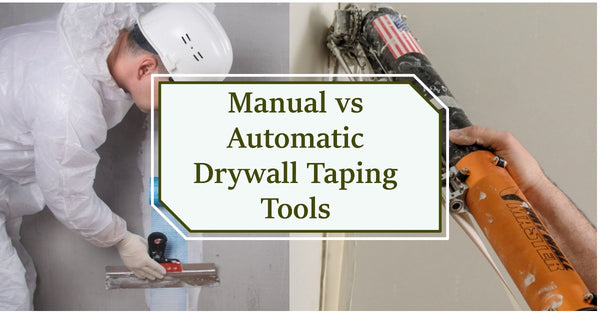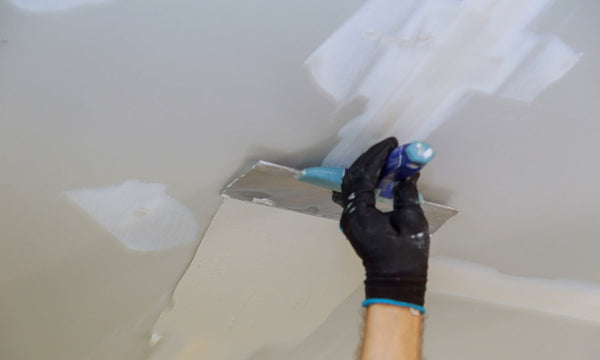Award Winning Service
Award Winning Service


Automatic taping tools, such as the Automatic Taper, Automatic Drywall Taper, Flat Box, and TapeTech products, offer a range of benefits and drawbacks for drywall taping professionals and DIY enthusiasts.
Automatic taping tools are designed to significantly speed up the drywall taping process. They can apply joint compound and tape at the same time, reducing the number of steps and allowing you to finish your project faster. This is especially useful for large-scale projects or professionals who must complete multiple tasks quickly.
You can achieve more consistent results by getting an automatic taping tool set. These tools are intended to apply a consistent layer of joint compound and tape, resulting in a smoother, more professional-looking finish. This consistency is critical for producing a high-quality end result, particularly in commercial projects where appearance is important.
Because automatic taping tools require less manual labor than traditional manual tools, they can reduce physical fatigue. This means you can work for longer periods of time without becoming exhausted, which is especially important for professional drywall installers who work on multiple projects at the same time or who have back to back project.

An Angle Head and Angle Box Combination allows for easy and quick application of drywall mud to corners. This reduces the time needed to finishing corners and reduces the stress on your body in the long allowing for a quicker and more consistent finish.
One of the primary disadvantages of automatic taping tools is their high initial cost. They are significantly more expensive than manual tools, requiring a large investment from individuals or small contractors. However, increased efficiency and productivity can help offset this cost in the long run.
Automatic taping tools have more moving parts and can be more complex than manual tools. As a result, they may require more maintenance and repairs, which can be expensive and time-consuming. It is critical to balance the potential maintenance costs with the benefits of using an automatic tool.
There is a learning curve associated with using automatic taping tools. It takes time to master, and inexperienced users may struggle to achieve consistent results at first. This learning curve, however, can be overcome with practice and proper training.
Manual taping tools, such as drywall joint and taping knives with a drywall mud pan or a hawk and trowel, have their own set of benefits and drawbacks.
Manual taping tools are less expensive than automatic tools, making them an attractive option for do-it-yourselfers and small contractors. Because of the lower initial cost, manual tools are more affordable for those on a tight budget or who only need them for occasional projects.
Manual taping tools are relatively easy to learn, especially compared to their automatic taping tools like the taping bazooka. Most people can quickly pick up the skills required to use a taping knife and joint knife effectively, making them a suitable choice for beginners or those with limited experience.

Using a drywall taping knife to spread and feather joint compound over a joint.
Using manual taping tools allows for greater control over the taping process. You can adjust the amount of joint compound applied and the pressure used to smooth out the tape, which can lead to a more customized finish.
One of the main disadvantages of manual taping tools is that they are typically slower than automatic tools. Manually applying joint compound and tape can be time-consuming, especially for larger projects or when working alone. This can be a major disadvantage for professionals who need to complete multiple tasks quickly.
Manual taping tools can lead to inconsistent results, as it can be challenging to maintain a consistent level of pressure and joint compound application. This may result in a less professional-looking finish that is unsuitable for commercial projects or those with high aesthetic standards.
Manual taping tools require more physical effort than automatic tools, which can lead to increased fatigue. This can make it difficult to complete large projects or work for extended periods, which may be a concern for professional installers or DIY enthusiasts tackling sizable projects.
To determine whether an automatic or manual taping tool is right for your project or career, you should first assess your specific needs. Consider the size and scope of your project(s), the level of finish you want to achieve, your experience with drywall taping, and the frequency in which you will be completing these types of jobs.
Your budget will also influence your decision. While automatic taping tools are initially more expensive, they can save time and effort in the long run, especially for professionals or large projects. On the other hand, manual tools are more affordable and may be a better option for smaller projects or occasional use.
Your drywall taping skill level and experience will also influence your decision. If you're new to taping or have only limited experience, a manual tool may be a better option because it's easier to learn and use. If you're a seasoned professional, the speed and efficiency of automatic tools may be worth the investment.
Ultimately, the choice between automatic and manual taping tools depends on your specific needs, budget, and experience level. Each tool has its own set of advantages and disadvantages, so carefully consider your needs before making a choice. With practice and patience, you'll be on your way to achieving a high-quality, professional-looking finish for your drywall project, no matter which tool you use.

No matter if you use automatic taping tools or manual tools you can achieve a professional taping and finishing job.
1. Are automatic taping tools worthwhile investments for DIYers?
It depends on the individual's needs and budget. While automatic tools can save time and effort, they have a higher initial cost. Manual tools may be a better option for occasional projects or smaller budgets. If you plan to work on large projects on a regular basis, the efficiency and consistency of automated tools may be worth the investment. We also recommend drywall taping banjos, which are often referred to as semi-automatic tools. Drywall banjos are typically faster than hand taping but slower than an automatic taper. The initial investment is much lower than that of automatic drywall tapers (also called taping bazookas).
2. How long does it take to become proficient with an automatic taping tool?
The learning curve for automatic taping tools varies depending on the individual's experience and the specific tool being used. With proper training and practice, most users can become proficient within a few weeks to a couple of months with frequent use.

It takes time to learn the Automatic Taper. Once you do it will greatly increase productivity.
3. Can I use manual taping tools to achieve professional results?
Yes, it is possible to achieve professional results with manual taping tools, but it may require more skill, patience, and practice than using automatic tools. Paying close attention to technique and ensuring consistent application of joint compound will help improve the final result.
4. What are some essential maintenance tips for automatic taping tools?
Cleaning and lubrication, such as TapeTech Bazooka Oil, are essential for keeping automatic taping tools in good working order. Clean off any excess joint compound and debris after each use, and lubricate moving parts as directed by the manufacturer. Inspect the tool on a regular basis for signs of wear or damage and address any issues as soon as possible. Most automatic taping tool manufacturers have a parts list that is widely available in order to repair the majority of your automatic taping tool equipment.
5. Do I need any additional tools or accessories when using an automatic taping tool?
While automatic taping tools handle much of the taping process, some additional tools and accessories are required for a complete drywall finishing job. Corner tools, sanding equipment, and various knives for smoothing and feathering joint compound are examples of these. In addition to the basic tools mentioned above, the following items may be required to supplement your automatic taping tool:
It's essential to have a well-rounded set of tools and accessories to handle various aspects of the drywall finishing process. By using the appropriate tools for each task, you can achieve a professional, high-quality finish regardless of whether you choose an automatic or manual taping tool. Whether you choose to go with automatic taping tools or manual tools you can find all your drywall tools for your next drywall job at Timothy’s Toolbox.
{"one"=>"Select 2 or 3 items to compare", "other"=>"{{ count }} of 3 items selected"}
Leave a comment